👗 The Business of Fashion in Europe – Jobs, Exports, and Digital Sales in 2025
Fashion is more than fabric in Europe — it’s a multi-billion-euro driver of jobs, exports, and innovation. In 2025, the European fashion industry remains a cornerstone of both cultural identity and economic power, accounting for over 1.3 million jobs, €115B+ in trade exports, and a fast-growing digital retail ecosystem.
From luxury brands and high street staples to fashion-tech startups and e-commerce platforms, Europe’s sector is being reshaped by sustainability regulations, AI innovation, and a demanding Gen Z market. This article provides a strategic, data-driven view of where fashion in Europe is heading in 2025 and beyond.
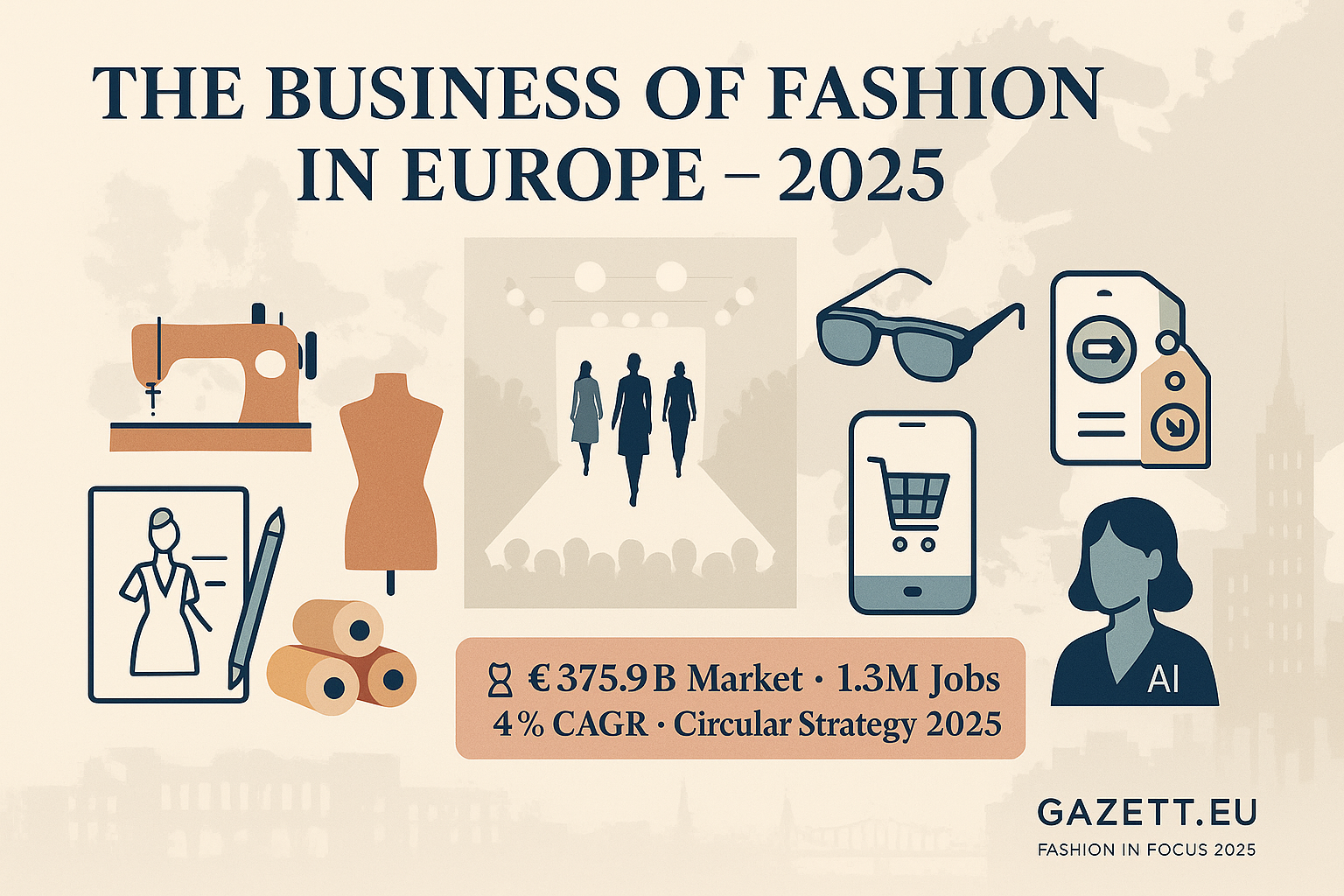
📷 Visual: European Fashion Industry – Jobs, Exports, and Digital Growth (Gazett.eu 2025)
📚 Table of Contents
- 📉 Employment & Job Market – From Designers to Retail
- 🌍 Exports & Trade – The Global Flow of EU Fashion
- 💻 Digital Sales & E-commerce Growth
- 🏷️ Key Players – From Luxury to D2C Disruptors
- ♻️ Sustainability & Regulation – Europe’s Circular Vision
- 🔮 2030 Outlook – Fashion, Tech & AI
- 📌 Conclusion + Summary Matrix
- 🔗 Sources + CTA
📉 Employment & Job Market – From Designers to Retail
In 2025, Europe’s fashion industry employs approximately 1.3 million people across 143,000 companies. The sector is led by small and medium-sized enterprises, with over 70% of workers being women, highlighting the industry's vital role in female employment and regional economic resilience.
Employment is distributed across both textiles (537,482 jobs) and clothing (760,637 jobs), spanning roles in design, tailoring, production, logistics, and retail. However, the rise of digital fashion tools, AI-enhanced marketing, and AR/VR retail experiences is reshaping demand for skills — pushing the sector to invest in digital reskilling and education.

📊 Visual: Workforce Distribution in European Fashion by Segment and Gender – Source: FashionUnited, EURATEX, EPRS
- 🧵 Textile jobs: 537,000+ roles across weaving, dyeing, finishing, and knitting.
- 👜 Clothing sector: Over 760,000 workers in tailoring, design, and apparel production.
- 👩🎨 Women in Fashion: 70%+ of EU fashion workers are female – a key pillar of inclusive employment.
- 📉 Retail job cuts: 169,000+ job losses in 2024 alone – e-commerce is accelerating closures.
- 🌿 New green jobs: Demand rising in repair centers, upcycling, and circular design practices.
Curious how Europe's fashion workforce is transitioning in the face of AI and sustainability goals? Dive into our upcoming section on Circular Strategies & EU Green Labeling.
🌍 Exports & Trade – The Global Flow of EU Fashion
In 2025, European fashion continues to expand its global footprint. The EU’s apparel exports reached $8.57 billion in January alone, up by 25.12% year-over-year, with a remarkable 41.10% surge in volume. This confirms Europe’s enduring role as a fashion powerhouse, catering to both luxury and mass-market segments across the globe.
Key destinations include the USA, UK, China, and UAE, while intra-EU trade among Italy, France, and Germany remains vibrant. Notably, the EU is also exporting more used textiles and sustainable apparel to Africa and Asia, aligning with its circular economy mission.
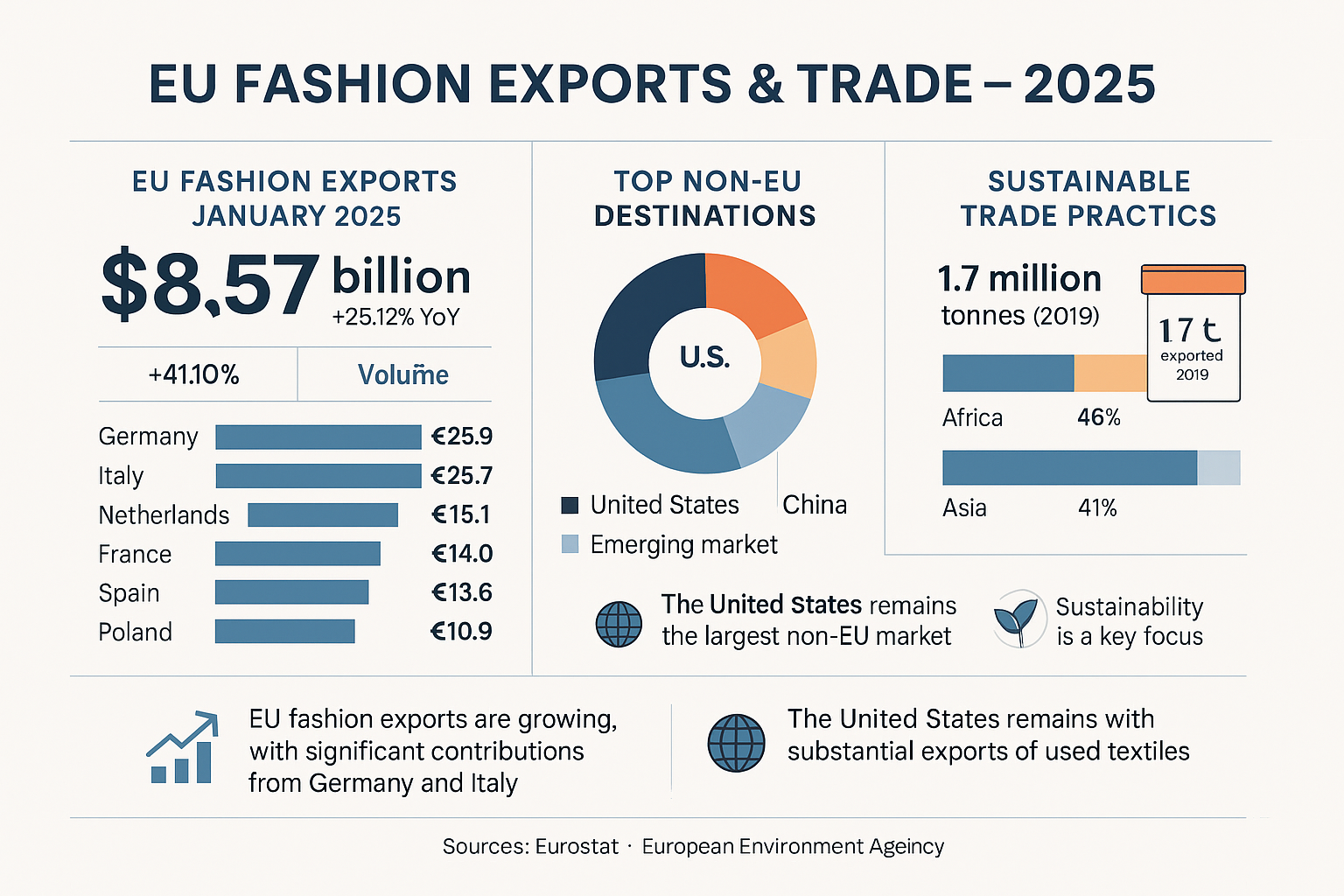
🌐 Visual: Top Global Destinations & Export Volume Trends of EU Fashion – Source: Eurostat, EEA, McKinsey
- 📦 $8.57B exports in Jan 2025 – 25% YoY growth, 41% volume rise (Eurostat).
- 🇺🇸 USA & UK remain key buyers of high-value fashion goods.
- 🇨🇳 China still dominates luxury demand despite slowdowns.
- 🇸🇦 Gulf countries see rising imports led by millennial shoppers.
- 🔄 Used textiles exports: 1.7M tonnes/year – major flows to Africa & Asia.
- ♻️ Sustainability in focus: DPP and circular practices embedded in trade strategy.
Next up, explore how Europe is transforming fashion commerce through digital tools in E-commerce & Online Sales Trends 2025.
💻 Digital Sales & E-commerce Growth
By 2025, European fashion e-commerce is forecast to reach a staggering $974.87 billion, driven by mobile-first consumer behavior and deep integration of digital tools. With a 10.7% annual growth rate, the sector has become a key pillar of fashion retail, dominated by brands like Zara, ASOS, and Zalando.
The industry is evolving rapidly: 76% of shoppers now buy fashion via mobile, 67% expect personalized product feeds, and 62% actively seek sustainable options online. This has led to widespread adoption of technologies like AI-powered recommendations, AR try-on features, and smart UX design across leading platforms.
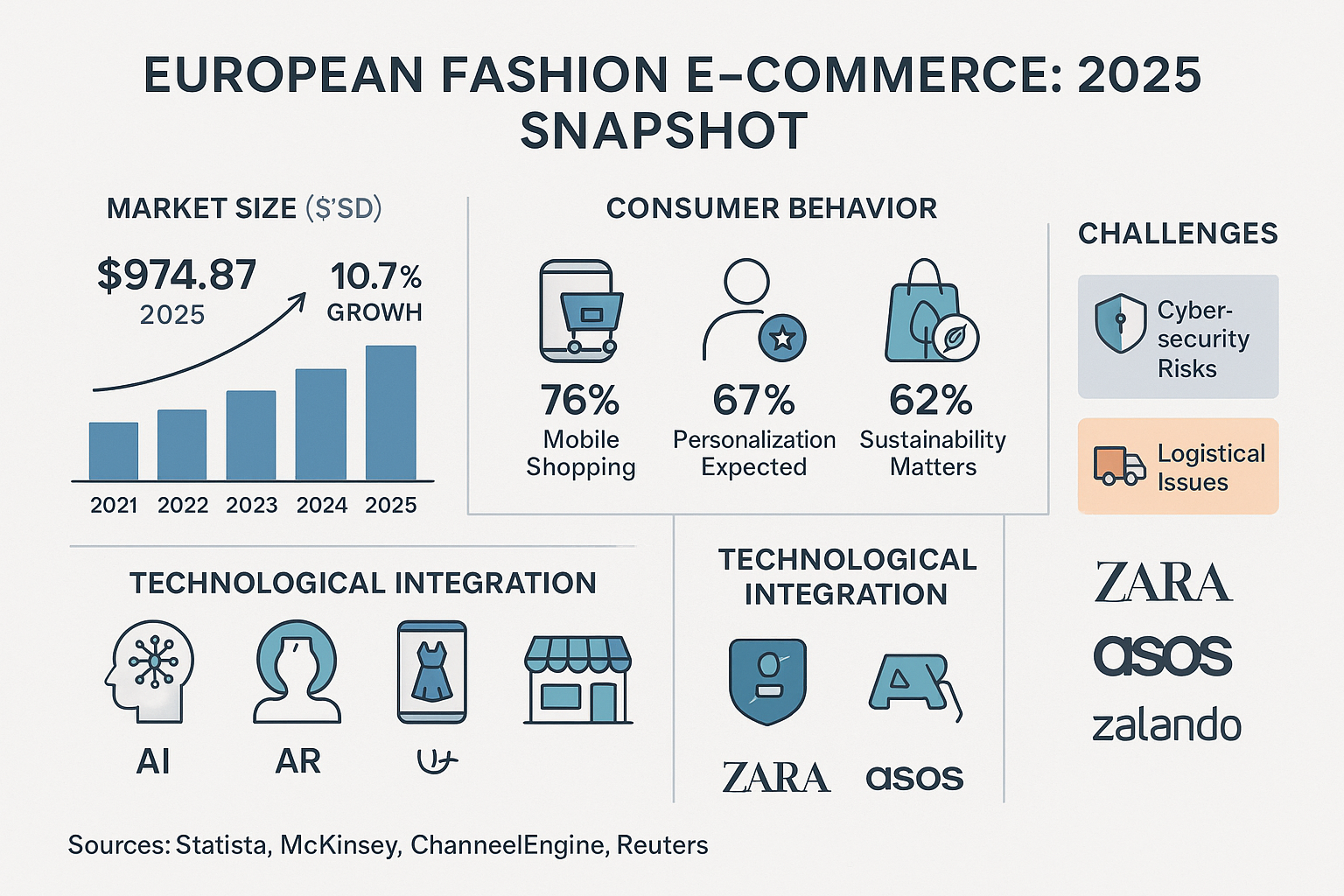
📊 Visual: Market Size, Consumer Trends, Tech Integration – Source: Statista, McKinsey, ChannelEngine
- 📱 76% of European consumers shop fashion via mobile.
- ⭐ 67% expect personalized shopping experiences.
- 🌿 62% prioritize eco-conscious products online.
- 🧠 AI, AR, UX dominate the tech stack of top fashion brands.
- 🛒 Market size: $974.87B by end of 2025 (10.7% CAGR).
Coming up next: Who’s winning the branding war? Discover major disruptors and iconic names in Europe’s Fashion Brand Landscape.
💻 European Fashion E-commerce: 2025 Snapshot

📊 Infographic: Market Size Growth, Consumer Preferences, and Tech Innovations in 2025 – Sources: Statista, ChannelEngine, Reuters
- 📈 Market Growth: $974.87B forecast in 2025 with 10.7% YoY growth.
- 📱 Mobile Commerce: 76% of users shop via mobile devices.
- ⭐ Personalization: 67% expect tailored product experiences.
- 🌿 Sustainability: 62% prefer eco-conscious digital fashion brands.
- 🧠 Tech Stack: AI, AR, smart UX transforming platforms like Zalando.
These insights form the foundation of Europe’s fast-evolving digital fashion economy. Let’s now explore who the major brand players are, and how they compete across channels in the next section on 🏷️ Key Players – From Luxury to D2C Disruptors.
🏷️ Key Players – From Luxury to D2C Disruptors
Europe's fashion landscape in 2025 is a blend of established luxury houses and agile digital-native brands. While giants like LVMH and Inditex continue to dominate, emerging D2C disruptors are reshaping consumer expectations with innovative approaches and sustainable practices.
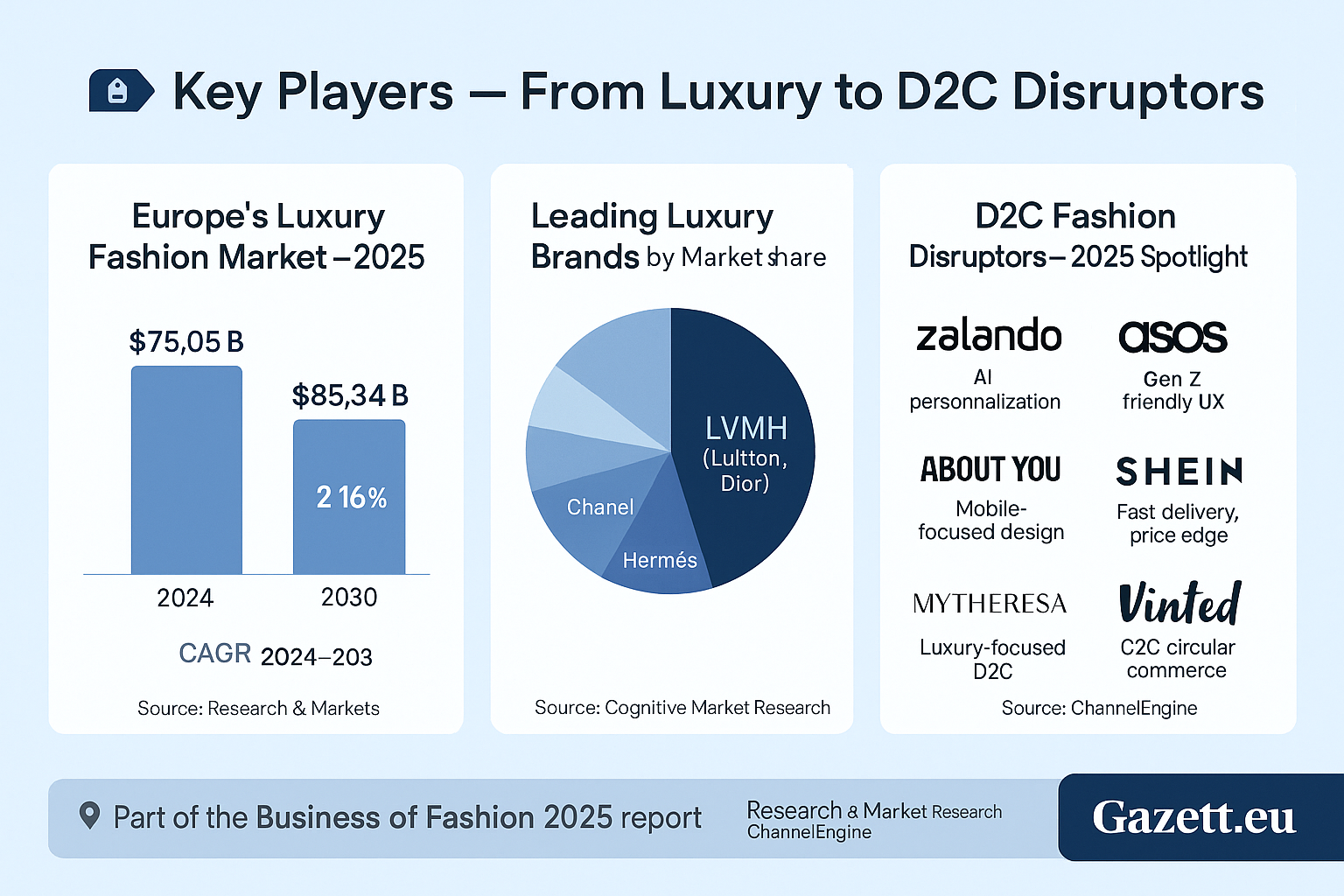
🧩 Visual: Market Leaders and Innovators in European Fashion – Source: Statista, ChannelEngine, Reuters
LVMH
Luxury conglomerate leading in global fashion and accessories.
Inditex
Parent company of Zara, leading in fast fashion retail.
Zalando
Leading online platform integrating AI for personalized shopping experiences.
ASOS
UK-based online retailer known for its trendy apparel offerings.
About You
German fashion platform focusing on personalized shopping experiences.
Shein
Chinese fast fashion brand expanding rapidly in European markets.
These brands exemplify the dynamic nature of Europe's fashion industry, blending tradition with innovation to meet evolving consumer demands.
♻️ Sustainability & Regulation – Europe’s Circular Vision
In 2025, the European Union is advancing its commitment to sustainable fashion through comprehensive regulations and initiatives aimed at transforming the textile industry into a circular economy. Key components include the Ecodesign for Sustainable Products Regulation (ESPR) and the introduction of Digital Product Passports (DPPs), which enhance transparency and traceability across the supply chain.

🧩 Visual: EU Circular Fashion Strategy – Source: European Commission, EPRS, Carbonfact
- 🧵 ESPR: Sets ecodesign requirements for textiles, focusing on durability, recyclability, and environmental impact.
- 📄 Digital Product Passports: Provide detailed information on product lifecycle, materials, and sustainability credentials.
- ♻️ Extended Producer Responsibility (EPR): Mandates that producers are responsible for the end-of-life management of textile products.
- 🌿 Green Claims Directive: Aims to prevent greenwashing by requiring substantiated environmental claims.
- 🛍️ Consumer Empowerment: Initiatives like the “Reset the Trend” campaign encourage sustainable consumer choices.
These measures are part of the EU's broader strategy to achieve a fully circular economy by 2050, ensuring that fashion products are designed to last longer, are easier to repair, and can be recycled efficiently. The implementation of these regulations is expected to significantly reduce textile waste and promote sustainable practices across the industry.
🔮 2030 Outlook – Fashion, Tech & AI
By 2030, Europe’s fashion industry will be profoundly reshaped by artificial intelligence, circularity, and next-generation tech. Forecasts indicate the fashion-AI market alone will reach $18.3 billion, with core applications spanning product recommendations, trend forecasting, and virtual try-ons.
Simultaneously, circular fashion — including resale, rental, repair, and recycling — is projected to dominate 2030 market share. With EU legislation like Digital Product Passports and Extended Producer Responsibility taking hold, the future of European fashion is not just digital — it’s also sustainable, trackable, and smart.
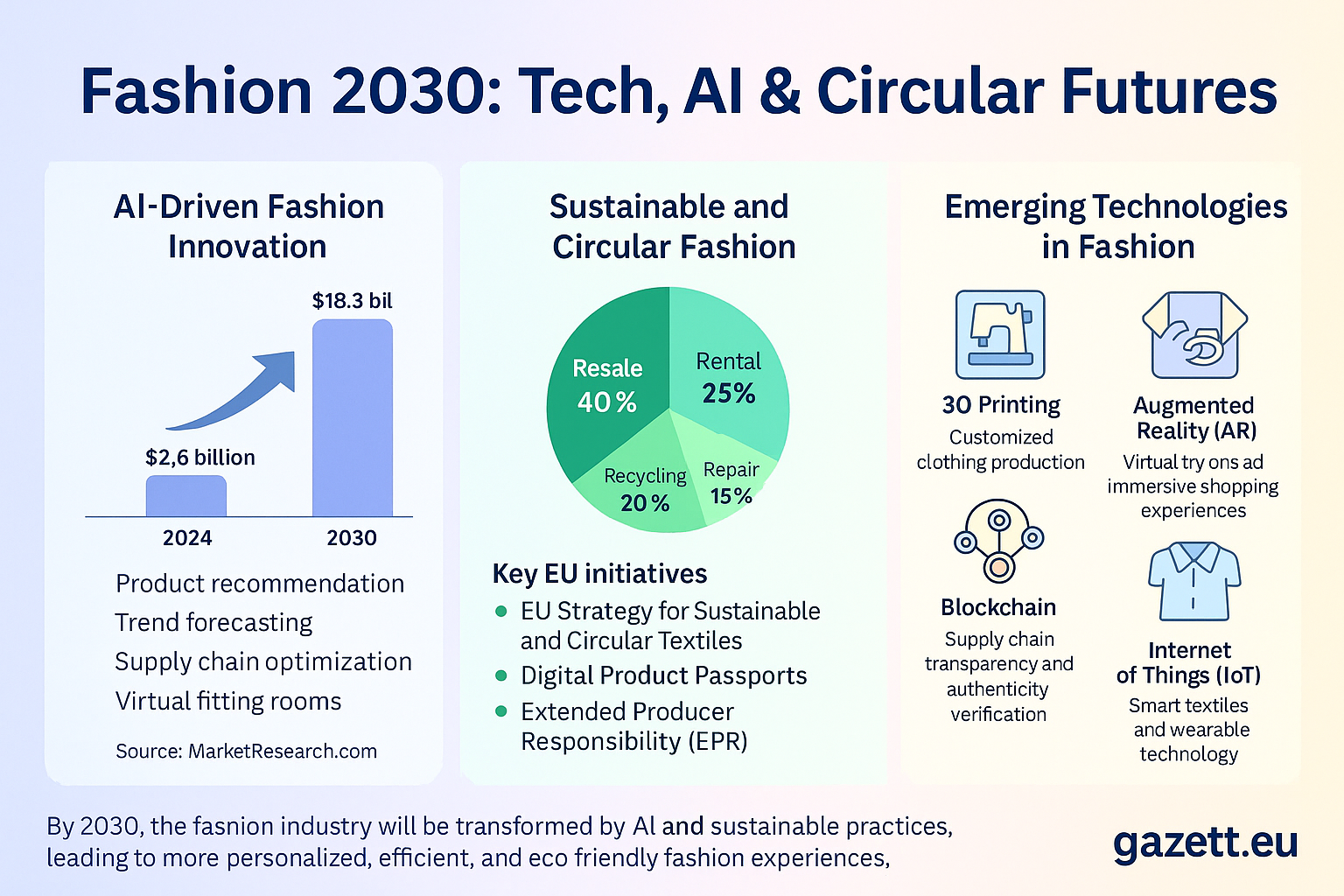
📊 Visual: AI Growth • Circular Share • Emerging Tech – Sources: MarketResearch.com, EU Commission, Gazett.eu
- 🤖 AI in fashion: $18.3B market by 2030 (38.4% CAGR).
- ♻️ Circular share: Resale 40%, Rental 25%, Repair 15%, Recycling 20% (projected).
- 🧪 Emerging tech: 3D printing, AR/VR, blockchain, IoT wearables.
- 📄 DPPs + EPR: Core regulatory tools for EU fashion compliance.
Ready to wrap it all up? Continue to 📌 Conclusion + Summary Matrix to see all key insights from this report in one place.
📌 Conclusion + Summary Matrix – Fashion in Europe 2025
Europe’s fashion industry in 2025 stands at a transformative crossroads — driven by technology, challenged by sustainability imperatives, and inspired by emerging digital consumer behaviors. From job creation and textile exports to AI-powered retail and circular product regulations, fashion continues to be an economic, cultural, and technological force across the continent.
As the EU accelerates toward 2030 climate and digital goals, companies that prioritize transparency, innovation, and circularity will define the new luxury and value segments. Whether you're a founder, policymaker, or global investor — the European fashion sector offers both scale and sustainability.
| Key Area | 2025 Insights | 2030 Outlook |
|---|---|---|
| Employment | 1.3M+ direct jobs, 70%+ women, 143K companies | Growth in green jobs, reskilling, tech-enabled retail |
| Exports | $8.57B exports in Jan, US/UK top markets | Digital trade + circular product exports rising |
| E-commerce | $974B market, 76% mobile-first, AI personalization | 3D try-ons, subscription D2C models dominate |
| Sustainability | ESPR, DPP, Green Claims Directive | Mandatory repair + extended producer responsibility |
| Tech & AI | $18.3B AI market by 2030, 38.4% CAGR | Smart fabrics, blockchain traceability, AR adoption |
✅ This report was independently compiled for Gazett.eu using verified sources including Eurostat, EPRS, McKinsey, Statista, and official EU policy portals.
🔗 Sources – Verified 2025 Data & Disclosures
This report was compiled using verified data from EU policy documents, market research firms, and industry platforms. All statistics related to employment, exports, sustainability, D2C trends, and AI adoption were sourced from official 2025 publications. The article was independently developed by Gazett.eu without any commercial sponsorship or affiliate inputs.
External data referenced from: Eurostat, European Parliament Research Service (EPRS), EURATEX, McKinsey State of Fashion 2025, Statista Fashion Market Outlook, MarketResearch.com AI Forecasts, Carbonfact, European Commission’s Circular Economy Reports, ChannelEngine, Zalando & Inditex annual disclosures.
For further reading, please visit the official source sites:
EU Textile Strategy |
EURATEX |
EPRS |
Statista Market Outlook |
McKinsey – State of Fashion |
Carbonfact |
Explore more verified insights on Gazett.eu